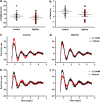Genetic and clinical factors predict lithium's effects on PER2 gene expression rhythms in cells from bipolar disorder patients
- PMID: 24150227
- PMCID: PMC3818008
- DOI: 10.1038/tp.2013.90
Genetic and clinical factors predict lithium's effects on PER2 gene expression rhythms in cells from bipolar disorder patients
Abstract
Bipolar disorder (BD) is associated with abnormal circadian rhythms. In treatment responsive BD patients, lithium (Li) stabilizes mood and reduces suicide risk. Li also affects circadian rhythms and expression of 'clock genes' that control them. However, the extent to which BD, Li and the circadian clock share common biological mechanisms is unknown, and there have been few direct measurements of clock gene function in samples from BD patients. Hence, the role of clock genes in BD and Li treatment remains unclear. Skin fibroblasts from BD patients (N=19) or healthy controls (N=19) were transduced with Per2::luc, a rhythmically expressed, bioluminescent circadian clock reporter gene, and rhythms were measured for 5 consecutive days. Rhythm amplitude and period were compared between BD cases and controls with and without Li. Baseline period was longer in BD cases than in controls. Li 1 mM increased amplitude in controls by 36%, but failed to do so in BD cases. Li 10 mM lengthened period in both BD cases and controls. Analysis of clock gene variants revealed that PER3 and RORA genotype predicted period lengthening by Li, whereas GSK3β genotype predicted rhythm effects of Li, specifically among BD cases. Analysis of BD cases by clinical history revealed that cells from past suicide attempters were more likely to show period lengthening with Li 1 mM. Finally, Li enhanced the resynchronization of damped rhythms, suggesting a mechanism by which Li could act therapeutically in BD. Our work suggests that the circadian clock's response to Li may be relevant to molecular pathology of BD.
Figures




Similar articles
-
Chronotype and cellular circadian rhythms predict the clinical response to lithium maintenance treatment in patients with bipolar disorder.Neuropsychopharmacology. 2019 Feb;44(3):620-628. doi: 10.1038/s41386-018-0273-8. Epub 2018 Nov 16. Neuropsychopharmacology. 2019. PMID: 30487653 Free PMC article.
-
Calcium channel genes associated with bipolar disorder modulate lithium's amplification of circadian rhythms.Neuropharmacology. 2016 Feb;101:439-48. doi: 10.1016/j.neuropharm.2015.10.017. Epub 2015 Oct 22. Neuropharmacology. 2016. PMID: 26476274 Free PMC article.
-
Disinhibition of the extracellular-signal-regulated kinase restores the amplification of circadian rhythms by lithium in cells from bipolar disorder patients.Eur Neuropsychopharmacol. 2016 Aug;26(8):1310-9. doi: 10.1016/j.euroneuro.2016.05.003. Epub 2016 May 20. Eur Neuropsychopharmacol. 2016. PMID: 27216486
-
Genetic polymorphisms associated with circadian rhythm dysregulation provide new perspectives on bipolar disorder.Bipolar Disord. 2018 Sep;20(6):515-522. doi: 10.1111/bdi.12624. Epub 2018 Feb 13. Bipolar Disord. 2018. PMID: 29441659 Review.
-
Lithium and suicide prevention in bipolar disorder.Encephale. 2016 Jun;42(3):234-41. doi: 10.1016/j.encep.2016.02.006. Epub 2016 Mar 19. Encephale. 2016. PMID: 27000268 Review.
Cited by
-
Chronotype and cellular circadian rhythms predict the clinical response to lithium maintenance treatment in patients with bipolar disorder.Neuropsychopharmacology. 2019 Feb;44(3):620-628. doi: 10.1038/s41386-018-0273-8. Epub 2018 Nov 16. Neuropsychopharmacology. 2019. PMID: 30487653 Free PMC article.
-
Differential serum levels of CACNA1C, circadian rhythm and stress response molecules in subjects with bipolar disorder: Associations with genetic and clinical factors.J Affect Disord. 2024 Dec 15;367:148-156. doi: 10.1016/j.jad.2024.08.238. Epub 2024 Sep 2. J Affect Disord. 2024. PMID: 39233237
-
An altered peripheral IL6 response in major depressive disorder.Neurobiol Dis. 2016 May;89:46-54. doi: 10.1016/j.nbd.2016.01.015. Epub 2016 Jan 22. Neurobiol Dis. 2016. PMID: 26804030 Free PMC article.
-
RNA expression profiling in depressed patients suggests retinoid-related orphan receptor alpha as a biomarker for antidepressant response.Transl Psychiatry. 2015 Mar 31;5(3):e538. doi: 10.1038/tp.2015.9. Transl Psychiatry. 2015. PMID: 25826113 Free PMC article.
-
Inhibition of glycogen synthase kinase 3 by lithium, a mechanism in search of specificity.Front Mol Neurosci. 2022 Nov 24;15:1028963. doi: 10.3389/fnmol.2022.1028963. eCollection 2022. Front Mol Neurosci. 2022. PMID: 36504683 Free PMC article. Review.
References
-
- McGuffin P, Rijsdijk F, Andrew M, Sham P, Katz R, Cardno A. The heritability of bipolar affective disorder and the genetic relationship to unipolar depression. Arch Gen Psychiatry. 2003;60:497–502. - PubMed
-
- McCarthy MJ, Welsh DK. Cellular circadian clocks in mood disorders. J Biol Rhythms. 2012;27:339–352. - PubMed
-
- Reick M, Garcia JA, Dudley C, McKnight SL. NPAS2: an analog of clock operative in the mammalian forebrain. Science. 2001;293:506–509. - PubMed
Publication types
MeSH terms
Substances
Grants and funding
LinkOut - more resources
Full Text Sources
Other Literature Sources
Medical
Miscellaneous

